





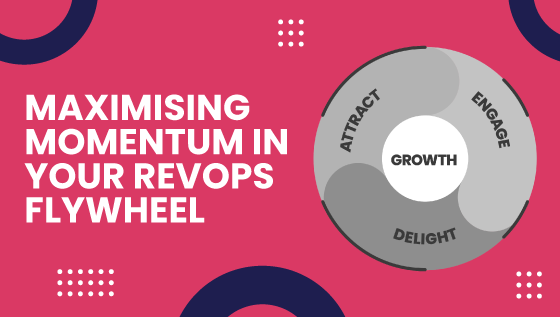
The siloed approach of managing operations is not an effective way to function in the fast-paced era we operate in.
While some may argue that incorporating specialisation is a more efficient way to manage operations; when viewed from a broader perspective, it's clear that this approach often leads to communication gaps and inefficiencies between teams, ultimately impacting customer satisfaction - which is the ultimate end goal.
In the world of SaaS, where continuous renewals, advocacy, and referrals are paramount, the traditional funnel model gives way to a more dynamic concept—the flywheel.
In this blog, we delve into the concept of flywheel, how it's better than the traditional funnel model, force and friction within the flywheel, and finally explore how RevOps emerges as a strategic solution to maximise momentum, addressing challenges that hinder optimal flywheel performance.
Introduction to The Flywheel
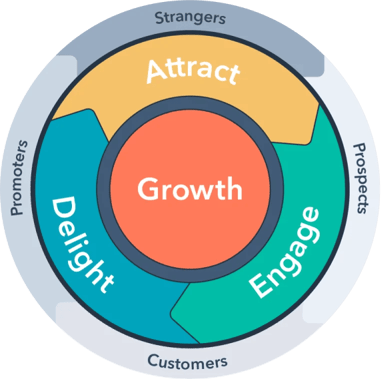
The Flywheel model represents the perpetual motion gained when an organisation aligns itself around delivering an exceptional customer experience.
With inbound methodology at the core, here's how a flywheel works:
1. Attract:
The attract stage of the flywheel model is all about capturing the attention of prospects through engaging and informative content. By focusing on creating valuable resources and delivering compelling insights, your marketing team can lay the foundation for building strong relationships and ultimately converting these prospects into loyal customers
2. Engage
Once these prospects have been nurtured by your marketing team, the sales team steps in to engage with these prospects in a personalised way to turn them into customers. Reflect on how your business connects with individuals - what are the various touchpoints your prospects have with your company? This crucial step in the flywheel model involves building strong relationships and understanding the specific needs and pain points of each prospect.
3. Delight:
After these prospects have transformed into loyal customers, the focus shifts to continually delighting them. This is where the dedicated service team plays a vital role, providing unwavering support throughout all the necessary processes and regularly checking in with them.
Flywheel VS Traditional Funnel
Customer lifecycles and growth cannot be looked at through the traditional funnel anymore. We've come a long way in optimising operations, helping us realise that analysing a customer experience journey through a funnel is not a holistic way of looking at it.
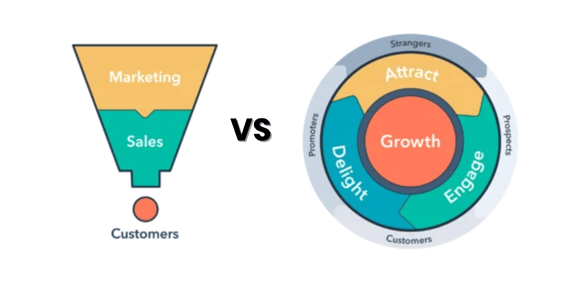
Source: What is a Sales Funnel?, HubSpot
Traditionally, businesses have viewed customer journeys as linear processes that start with attracting prospects, converting them into customers, and then considering the job done. However, this outdated approach fails to acknowledge the continuous nature of customer relationships and the potential for ongoing growth.
A funnel implies an end, which is never the case with customer journeys as they are never-ending - like a circle! The customer journey is a dynamic and ever-evolving process that requires businesses to constantly adapt and engage with their customers.
And it's imperative for businesses to adopt the new perspective - one that recognises the cyclical nature of customer lifecycles. Rather than viewing the customer journey as a linear funnel, businesses should embrace the concept of a flywheel.
By shifting from a funnel mindset to a flywheel mindset, businesses can create a virtuous cycle of growth. Instead of focusing solely on acquiring new customers, they can invest in building strong relationships and delivering ongoing value to their existing customers. This not only leads to increased customer satisfaction but also drives customer advocacy, referrals, and ultimately, sustainable growth.
Spinning the Flywheel: Force & Friction
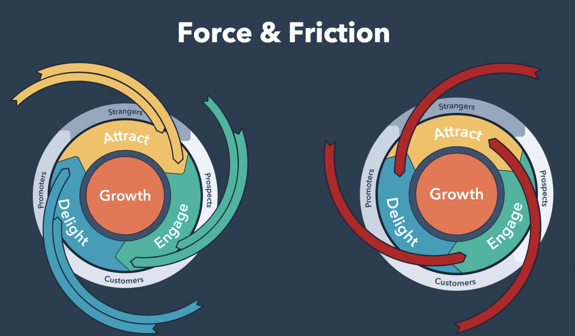
Source: Revenue Operations, HubSpot Academy
As the components of the flywheel begin to work together, the flywheel begins to spin. Depending on the team's performance and operational efficiencies it may spin fast or slow, this is called the flywheel effect.
Anything that your team does to make the flywheel spin faster and most effortlessly is called force, on the contrary any obstacle that slows down the flywheel is called friction.
Force
Force is about identifying areas to improve customer attraction, engagement, and delight.
Reviewing and adjusting your sales and marketing processes to focus on customer satisfaction can create a positive cycle, driving growth through word of mouth and customer advocacy.
Investing in delighting your customers is a great way to guarantee sustainable growth. Essentially this involves more than just traditional customer support; it extends to non-obvious opportunities in marketing and sales. This may include investing in improving customer experience, introducing chatbots, creating extensive lists of topic clusters to provide value, incentivising customer retention strategies - to name a few.
Friction
Friction is about identifying areas that are creating obstacles in your customer journeys - these can be internal as well as external.
Externally, you must identify areas where customers face challenges, such as long wait times, lack of responsiveness, or difficulties in obtaining information. Prioritising and addressing these issues promptly can significantly enhance the customer experience.
Internally, look for processes that hinder customer-facing teams. This includes streamlining systems, reducing duplicate processes, and providing adequate training for employees. Focusing on these internal improvements ensures that your team can deliver a world-class experience to customers without unnecessary obstacles.
Although, it may seem like all friction is bad as it slows down growth, but that's really not the case as friction can actually prove useful in some cases. For instance, implementing strict criteria to qualify leads may complicate the process and narrow down the number of people to reach out to; however, this added complexity allows only the right audience to enter the flywheel and hence simplifies the process by letting sales team focus only on prospects who better fit our ICP and persona.
RevOps in Action
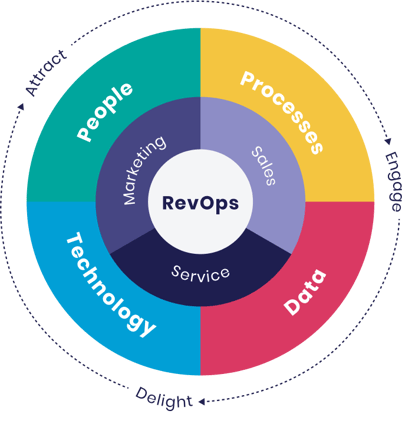
Now that we have identified the difference between force and friction as well as good and bad friction, it's crucial to optimise good friction and remove bad friction ensuring the flywheel spins seamlessly, hence increasing opportunities for scale and growth.
1. Increased collaboration and alignment among teams
With RevOps taking up the centre of the flywheel, each operating team within the company becomes aligned and collaborate effectively to work towards a common goal. Each team focuses on building the foundations of RevOps - people, processes, technology, and data, through which the flywheel essentially operates.
By aligning all the teams to work together, RevOps allows a space to optimise customer journey by analysing the entire flywheel and how each team contributes to make it spin faster.
By mapping out this journey, RevOps professionals can identify points of friction and work towards streamlining the overall process.
2. Focus on doing less
Doing less with more is fundamental in RevOps, helping teams to increase velocity by removing the various inefficiencies they incur within their processes, technology, and/or data. By streamlining operations and eliminating unnecessary tasks, teams can focus on what really matters and allocate their resources more effectively. This approach allows them to achieve greater efficiency and productivity, ultimately leading to improved performance and better outcomes.
By doing less, teams can also free up valuable resources that can be redirected towards higher-value activities. This could involve automating repetitive tasks, streamlining processes, or leveraging technology to improve efficiency. By eliminating inefficiencies and reducing the time and effort spent on activities enabling friction, teams can devote more time and energy to activities that drive growth and deliver value to the organisation.
3. Centralised information
When teams operate in silos, it creates a fragmented environment where the exchange of information and data is limited to their individual departments. This lack of collaboration becomes a breeding ground for information gaps, miscommunication, inefficient handovers, and delays in issue resolution. It not only hinders productivity but also affects the overall customer experience.
However, by aligning all the teams and centralising information and data, Revenue Operations (RevOps) plays a pivotal role in breaking down these silos and ensuring that all teams have access to accurate and up-to-date information. This centralisation promotes transparency, collaboration, and improved communication channels between departments.
With a centralised information system in place, teams can easily share data, insights, and updates, enabling a more holistic understanding of the customer journey. This shared knowledge allows for better coordination and collaboration, as teams can align their efforts towards a common goal.
4. Process optimisation
With optimised RevOps, teams can effectively analyse existing processes to identify inefficiencies and bottlenecks. By conducting a thorough evaluation, they can pinpoint areas that are causing friction in the customer journey. This involves closely examining workflows and ensuring that each step aligns with the specific needs and preferences of the customers.
Through this process of optimisation, RevOps professionals can eliminate any unnecessary steps that contribute to bad friction. By streamlining processes and removing obstacles, they create a more seamless and enjoyable experience for customers while also enhancing the overall efficiency of the business operations.
This customer-centric approach allows businesses to deliver personalised experiences that resonate with their target audience. By understanding and addressing the pain points of customers, RevOps professionals can make strategic adjustments that further enhance the customer journey.
5. Continuous training and development
Continuous training and development programs help employees stay updated with the latest industry trends, strategies, and best practices. This enables them to deliver exceptional customer experiences, minimise errors, and reduce the likelihood of miscommunication. It also empowers teams to proactively identify and address any issues that may contribute to bad friction in the customer journey.
By prioritising ongoing training and development for sales, marketing, and service teams, businesses can ensure that their employees have the knowledge, skills, and confidence to provide exceptional customer experiences.
In conclusion, by adopting an inbound approach and understanding the full loop of the customer lifecycle, organisations can leverage RevOps to optimise force and address friction
To optimise your business flywheel, it is vital to master the art of balancing force and friction. Start by thoroughly mapping out your flywheel, identifying the areas where force and friction play a role, and prioritising the reduction of any negative elements. As you make progress, it is crucial to understand and appreciate the intricate interplay between positive and negative force and friction, creating a finely-tuned flywheel that propels your business towards sustainable growth.








